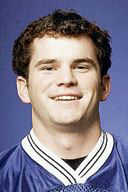 Some readers in the Triangle are upset with The News & Observer for publishing a photo of a Duke lacrosse player in a recent story. Fred Krom is not one of the players charged in that well-publicized rape investigation, but the DA in the case wants information from him and other people. Krom's attorneys call the request a "fishing expedition."
Some readers in the Triangle are upset with The News & Observer for publishing a photo of a Duke lacrosse player in a recent story. Fred Krom is not one of the players charged in that well-publicized rape investigation, but the DA in the case wants information from him and other people. Krom's attorneys call the request a "fishing expedition."The objection from readers, many of whom already are angry at the paper for its coverage of the lacrosse team, say that running Krom's photo implies guilt. To them, it's another example of bias. Other N&O readers raised similar concerns during the 2004 campaign, when supporters of John Kerry objected to a frequently used file photo that they said made their candidate's face look like a withered tree trunk.
In both cases, the readers were reading more into the mugs than was intended, but their complaints do raise questions about how and why newspaper editors (as well as editors in other media) frequently run small images of people's faces with stories.
The faces of news
In this case, the N&O ran what appears to be a handout photo of Krom, probably from the media guide published by Duke's athletics department. Such "mug shots" appear frequently in American newspapers; the idea is to let readers see what people in the news look like. It's a standard and accepted practice in the profession. In this case, to run such a photo is not to pass judgment on Krom or on the legal issues discussed in the accompanying story.
It gets trickier when editors have the choice to run a true "mug shot" — the booking photograph made when a person is arrested or charged. Such images tend to be unflattering, even freaky, as the collection of mugs on The Smoking Gun illustrates. They serve the same function as the "perp walk" on TV news: They appeal to our uneasy fascination with the criminal. And in some cases, we even take some joy in the fact that the suspect has met justice. Knowing this, people such as Tom DeLay and Rush Limbaugh have literally put the best face possible on their recent mug shots by smiling as if they were posing for a family snapshot. Conversely, Time magazine made O.J. Simpson's mug shot even more ominous by darkening the frame around his face for an infamous 1994 cover image.
The Redick case
Schadenfreude was probably in play in another legal matter involving a Duke athlete, J.J. Redick. The former Blue Devil is one of those players who stirred strong emotions among basketball fans. Duke fans love him; fans of most other teams hate him. There is no middle ground.
 The arrest of Redick on DWI charges also created the need for an editorial decision: publish the "official" photo of Redick or the police "mug shot." The grainy photo shows a bleary-eyed Redick looking out of sorts.
The arrest of Redick on DWI charges also created the need for an editorial decision: publish the "official" photo of Redick or the police "mug shot." The grainy photo shows a bleary-eyed Redick looking out of sorts.The TV station that broke the story used the booking photo on its Web site, as did ESPN. The N&O used the Duke-issued "glamour shot" photo on its site, and then switched to the booking photo later in the day. It also used the booking photo in the newspaper. Ted Vaden, the newspaper's public editor, said he had received no complaints about the N&O's use of the unflattering image of Redick.
Conclusion
Editors should take care in the selection of what mugs are used and how they are used. What's important is that the image be representative of the person: Let's not pick a photo that captures a person in an awkward moment or that makes it difficult to discern to recongize the subject. As any editor who has looked through a collection of photos from a news conference would attest, still photography makes it easy to make anyone look foolish. As with everything journalists do, it helps to anticipate the reaction from readers.
In the crime stories, use of booking photos is often justified. In Redick's case, the image contributes to the storytelling. The photo, which portrays his condition at the time of his arrest, is news in and of itself. But it's important for editors not to revel in such photos or to pander to their readers by playing them too large or prominently.
